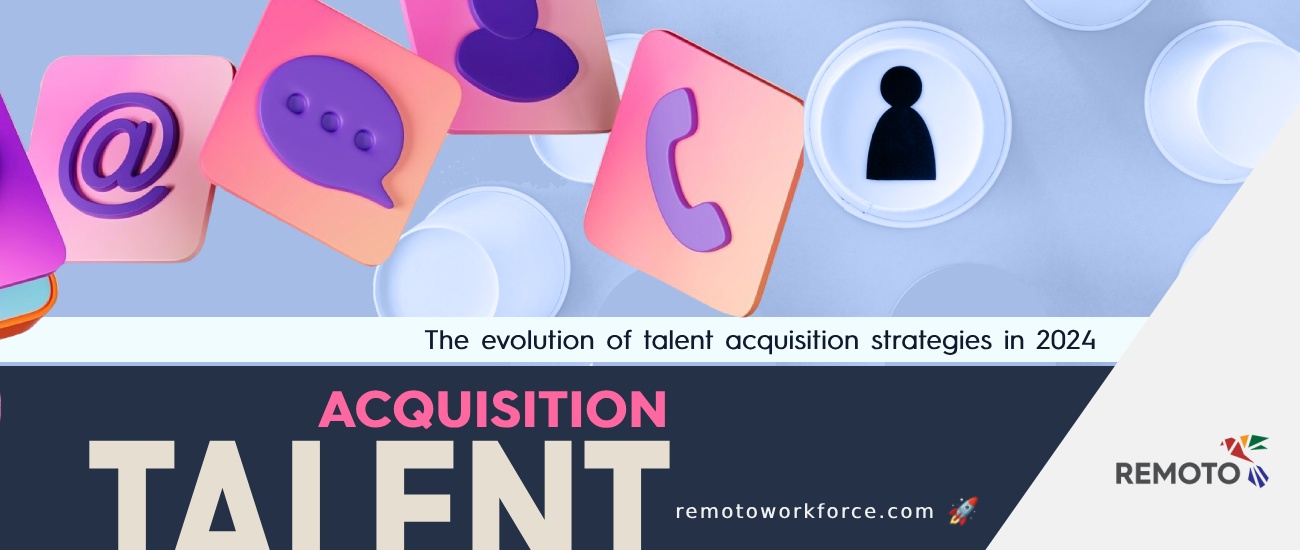The world of talent acquisition is evolving faster than ever before, and 2024 is set to be a transformative year. With rapid advancements in technology, a renewed focus on employee skills, and the impact of globalization, companies are rethinking their hiring strategies to stay competitive in a constantly shifting landscape.
To thrive in this dynamic environment, businesses need to embrace innovative approaches that attract top talent while fostering internal growth and development.
So, what exactly is driving the evolution of talent acquisition strategies in 2024? Let’s take a closer look at it.
AI-Powered Recruitment: A Game Changer in Talent Acquisition
Artificial intelligence (AI) is shaping talent acquisition in the here and now. With the introduction of tools like generative AI (GenAI), the recruitment process has become more streamlined, efficient, and data-driven. In 2024, AI will play a central role in reshaping how companies identify, engage, and hire talent.
The beauty of AI lies in its ability to handle mundane, time-consuming tasks, freeing up recruiters to focus on higher-value activities. AI-powered platforms can:
- Screen resumes
- Analyze job descriptions
- Predict which candidates are likely to succeed in specific roles based on historical data
For instance, chatbots are now handling the initial stages of candidate interactions, offering real-time responses and personalized follow-ups. This not only speeds up the recruitment process but also enhances the candidate experience.
AI is related to making recruitment decisions. AI tools can analyze vast amounts of data to identify trends, optimize job ads, and even suggest personalized outreach strategies to engage passive candidates.
But here’s the key: AI works best when paired with the human touch. While it can do the heavy lifting, recruiters still bring invaluable insight into understanding cultural fit and building meaningful relationships with candidates. It’s this balance of technology and human intuition that will define successful talent acquisition strategies in 2024.
Skills-Based Hiring: Shifting the Focus from Credentials to Competence
Gone are the days when hiring managers judged candidates solely by their degrees or job titles. In 2024, the focus is squarely on skills.
As industries evolve and the demand for specialized competencies grows, companies are rethinking how they evaluate talent. Skills-based hiring is becoming the gold standard, allowing employers to tap into a broader pool of candidates with the right expertise, even if they don’t have traditional credentials.
Skills-based hiring is linked to evaluating what candidates can do rather than where they’ve been. This shift has opened the door for individuals with non-linear career paths, self-taught professionals, and those with practical experience to land roles based on their capabilities.
Think about coding challenges for tech roles, real-world scenarios for customer service, or hands-on tests for creative positions. These tests show hiring managers how well a candidate can do the job instead of just looking at a good resume.
This approach is a win-win. For employers, it leads to a more diverse workforce, which is known to drive innovation and problem-solving. For candidates, it offers an opportunity to showcase their strengths and potential in ways that traditional qualifications never could.
As more companies embrace this mindset in 2024, we’ll see a dramatic shift in the way talent is sourced and nurtured. Companies that adapt will be the ones that attract the most creative, innovative, and dynamic individuals.
Upskilling and Reskilling: Building Talent from Within
In an era of rapid technological change, the skills required to succeed in most jobs are constantly evolving. This has led to a growing focus on upskilling and reskilling existing employees to bridge the skills gap.
In 2024, companies are realizing that they don’t always need to look for new employees. Instead, they can invest in the growth and development of their current workforce.
Upskilling refers to teaching employees new skills that allow them to grow within their current roles, while reskilling focuses on training them for entirely new roles within the company.
Both approaches are essential for businesses that want to remain agile and adaptable. By fostering a culture of continuous learning, companies can ensure that their workforce remains equipped to meet the demands of tomorrow’s jobs.
Moreover, upskilling and reskilling have a positive impact on employee engagement and retention. Workers who feel supported in their career development are more likely to stay loyal to the company and contribute to its long-term success.
It’s no surprise that businesses with strong internal mobility programs—where employees can move across departments and disciplines—tended to have higher employee satisfaction and retention rates. In 2024, the smartest companies will prioritize these programs to build future-ready teams from within.
The Rise of Remote and Hybrid Work: Expanding the Talent Pool
The global shift toward remote and hybrid work has revolutionized the way we think about hiring. In 2024, the ability to work remotely is no longer a perk—it’s a necessity for many job seekers.
This change has given companies access to a much larger and more diverse talent pool, breaking down geographical barriers and allowing businesses to hire the best candidates, regardless of location.
Remote work offers clear benefits for employers, from reduced overhead costs to greater workforce diversity.
However, it also comes with its own set of challenges, particularly when it comes to managing and integrating remote teams. Building a strong company culture and maintaining clear communication are essential for keeping remote employees engaged and productive.
Companies that embrace flexible work models will be better positioned to attract top talent in 2024.
This trend also ties into the growing emphasis on work-life balance, as more employees prioritize jobs that offer flexibility in both where and when they work. Companies that can offer this balance will be seen as more attractive to candidates, especially in a competitive job market.
Employer Branding: The Power of a Strong Reputation
Employer branding is a critical component of any talent acquisition strategy. Job seekers are more informed than ever, and they’re not just looking for a paycheck—they want to work for companies whose values align with their own. This makes a company’s reputation and culture key factors in attracting top talent.
Building a strong employer brand starts with authenticity. It’s about showcasing your company’s values, culture, and what makes it a great place to work. Whether through employee testimonials, social media engagement, or publicizing community involvement, companies need to tell a compelling story about who they are and why candidates should want to be a part of it.
The benefits of a strong employer brand are twofold. Not only does it help attract high-quality candidates, but it also boosts employee engagement and retention.
Workers who feel proud of their employer are more likely to stay with the company and become advocates for its mission.
In 2024, companies that prioritize building and maintaining a positive employer brand will stand out in the competitive talent market.
Diversity, Equity, and Inclusion (DEI): A Non-Negotiable Strategy
Diversity, equity, and inclusion (DEI) have been hot topics for several years, but in 2024, they are more important than ever.
Companies that fail to prioritize DEI in their hiring practices are missing out on both talent and innovation. It’s not enough to talk about diversity. Employers need to work hard to create environments that welcome different ideas and backgrounds.
A commitment to DEI doesn’t just benefit employees—it’s also good for business. Diverse teams are proven to be more innovative and better at solving complex problems. Moreover, many job seekers—especially younger generations—are prioritizing companies with strong DEI initiatives.
To succeed in 2024, companies must move beyond token gestures and implement real, measurable changes in their hiring and workplace practices. This could mean rethinking the way jobs are advertised, removing unconscious bias from the recruitment process, or establishing mentorship programs for underrepresented groups.
By building a truly inclusive workplace, organizations can attract a wider range of talent and drive long-term success.
Internal Mobility: Career Growth from Within
Internal mobility is set to become a major focus in talent acquisition strategies in 2024. As the competition for external talent intensifies, companies are looking inward to fill key roles and develop future leaders. The concept is simple: rather than constantly seeking new hires, organizations can nurture and promote talent from within.
The benefits of internal mobility are clear. It boosts employee morale, reduces turnover, and allows companies to retain institutional knowledge. Workers who see clear paths for career progression within their organization are more likely to stay and contribute to the company’s long-term success.
By investing in internal talent marketplaces—platforms that help employees explore new opportunities within the company—businesses can create a culture of continuous growth and development.
Moreover, internal mobility ties directly into the larger trend of upskilling and reskilling. As employees learn new skills and take on different roles, they become more valuable assets to the company. In 2024, companies that prioritize internal mobility will be the ones that build strong, adaptable teams capable of meeting future challenges.
The Future of Talent Acquisition: Adaptation is Key
The world of talent acquisition is changing rapidly, and the strategies that worked in the past won’t necessarily work in 2024.
To stay ahead, companies must be willing to adapt and embrace new technologies, new hiring models, and new ways of thinking about talent. Whether it’s leveraging AI to streamline recruitment, focusing on skills rather than credentials, or fostering internal mobility, the key to success in 2024 is flexibility.
But one thing remains constant: people. At the heart of every talent acquisition strategy is the human element. As much as technology will change the way we hire, the relationships we build with candidates, employees, and teams will continue to drive success.
By keeping a focus on both the technological and human sides of recruitment, companies can navigate the evolving talent landscape and come out on top.














